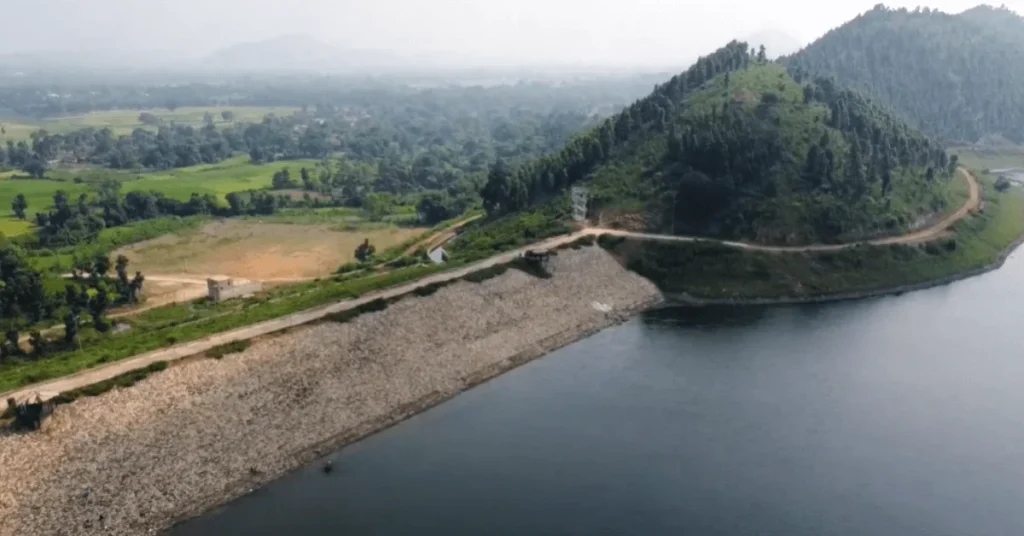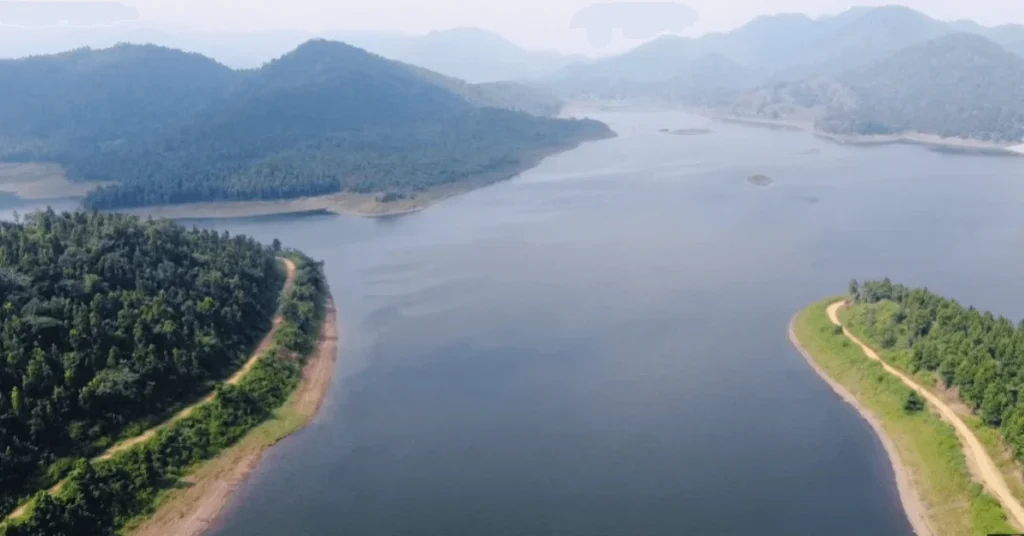Palna Dam in Seraikela-Kharsawan, Jharkhand – a serene tourist spot surrounded by lush greenery, tribal culture, and adventure activities. Learn its history, construction details, natural beauty, attractions, best time to visit, food, stay options, and more.
Introduction
Palna Dam is a very scenic and tranquil tourist spot located in Saraikela-Kharsawan district of Jharkhand which is an ideal destination for nature lovers and picnic enthusiasts. Surrounded by lush green mountains and forests, the dam is famous for its natural beauty and tranquil atmosphere.
The Palna Dam was inaugurated on January 14, 1983 by the then Chief Minister of United Bihar, Jagannath Mishra. Palna Dam is a beautiful and tranquil tourist spot located in Saraikela-Kharsawan district of Jharkhand.
Brief introduction to Palna Dam
It is located in Chandel Block under Saraikela District of Jharkhand State. The dam was completed in 1983. The dam was built by the Water Resources Department. The main objective of the dam was to provide regional irrigation and water conservation.
In addition, it also plays an important role in local water supply and environmental balance. It is situated on the Subarnarekha River. It is located near Dam Chowk, about 2 km inside NH-33, making it easy to reach. Located about 45 km from Jamshedpur, the dam can be reached directly by private vehicle or cab from near Chowka turn.
Geographical location, structure and technical details
Address: Palna Dam, Saraikella-Kharsawan, 832404, null, Chandil, Saraikela Kharsawan, Jharkhand, 832404.
Chandil Dam, located at a distance of 12 km from Palna Dam, is another major tourist destination. Boating facilities are available here.
The height of the dam is 39 meters and the length is 566 meters. The water storage capacity is 6.2 million cubic meters. The total geographical area of Palna village is about 395 hectares, which is approximately equal to 975 acres. But accurate information about the dam is not available.


History and construction background
The construction of Palna Dam began in 1959 and was completed in 1961. The height of the dam is 39 meters and the length is 566 meters. The water storage capacity of the reservoir formed by the dam is 6.2 million cubic meters. Palna Dam was constructed for the purpose of irrigation and water conservation.
The dam was inaugurated on 14 January 1983 by the then Chief Minister of united Bihar, Jagannath Mishra. The dam is built on a small river called Ranka Juria and is being branded by the tourism department of the Jharkhand government.
Over time, its structural damages and deterioration came to the fore. Therefore, in the year 2017, its renovation, modernization and expansion started under a project worth ₹51.30 crores, so that its capacity and reliability can be increased.
Natural beauty of Palana Dam
The natural beauty of Palana Dam attracts everyone. The greenery spread around it, lush green forests and foothills of mountain ranges make it popular among tourists. The picturesque view and calm environment around the dam makes people feel peace and relaxation. Many types of birds can be seen here throughout the year.
Many birds like peacock, heron, crane, myna, parrot, pigeon and sparrow are seen in the area around the dam. On the other hand, if we talk about water birds, then Siberian duck, grey heron, cormorant, Brahmini duck etc. can be seen.
The view here on the banks of the dam in the morning, sunrise and evening looks very good. The greenery of the environment all around, the calm atmosphere provides peace to the mind.
Tourism importance of Palana Dam
You can come here for a picnic in any season with your family and friends. This dam is also known as a popular picnic spot for the local people. There are many beautiful places around Palna Dam, where tourists do photography and videography. Activities like boating, water skiing, and kayaking can be enjoyed.
How to reach Palna Dam
Palna Dam is located in Chowka of Seraikela-Kharsawan district. It is located about two kilometers from the left side of Baramtand on the NH-33.
Palna Dam is located about 45 km from Jamshedpur, about 92 km from Ranchi and 12 km from Chandil. It can be easily reached by road. This is the most convenient way. You can reach by booking your personal vehicle or cab. The nearest railway station is Tatanagar Junction, from where you can easily reach Palna Dam by booking a taxi. The nearest airport is Birsa Munda Airport in Ranchi.
Nearby places of interest
- Chandil Dams
- Sheesh Mahal
- Jayda Temple
- Sai mandir
- Akashini Mandir
- Dalma Top
- Hesakocha Waterfall
- King Place
Things to do in Palna Dam
Tribal culture, traditions and handicrafts can be seen in the villages around Palna Dam. Activities like boating, water skiing, and kayaking can be enjoyed. You can go for picnics and family outings. There is a proper place for photography and videography.
Many local and migratory birds can be seen here. It is an attractive place for bird lovers. There is a possibility of boating in the dam, which can give tourists an exciting experience. Activities like small boats or kayaking make the trip here memorable.
The lush green forest and natural trails around the dam are suitable for walks. The hilly areas adjoining the dam are suitable for light trekking.
Local culture and traditions
The tribal community around Palna Dam is inhabited by Ho, Santhal, Munda and Oraon tribes. These communities lead a life based on agriculture, animal husbandry and forest. Chhau Dance – Saraikela-Kharsawan is world famous for this dance style.
This dance performed with masks and traditional costumes is performed on religious and cultural occasions. Jhumar and Tribal Dance – Performed in groups by villagers during harvest and festivals. Musical instruments like dhol, nagada, mandar and flute are used especially.
- Sarhul – This festival celebrated in the spring season is a symbol of worship of nature and sal tree.
- Karma Parv – Festival associated with brother-sister relationship and faith in forests.
- Makar Sankranti and Holi – Rural society celebrates with great enthusiasm.
- Local fairs – are related to traditional handicrafts, agricultural products and folk art.
- Dams and rivers are considered sacred by the local people. Special worship is done for rain, crops and river water. The community sees its livelihood and culture linked to nature.
Contribution of Palna Dam to Agriculture and Irrigation
Palna Dam was constructed mainly with the objective of water conservation, irrigation and rural development. The water stored in the dam reservoir is extremely useful for the surrounding agricultural land and farming in the villages. The water storage capacity of this dam is 6.2 million cubic meters.
The total geographical area of Palna village is about 395 hectares, which is equivalent to about 975 acres. With this much water, the water needs of the surrounding area can be met. Canals have been built through the dam to the fields, which provide irrigation facilities throughout the year.
Even when the rainfall is less, farmers get sufficient water for the crops. The water of the dam supports the cultivation of both Rabi and Kharif seasons. Due to the dam, major crops like paddy, wheat, maize and pulses are grown in a larger area.
Due to the irrigation facility, the continuity of farming is maintained even in drought-affected areas. The production of vegetables and cash crops (such as potatoes, tomatoes, oilseeds, etc.) has also increased. Allied activities like fisheries and animal husbandry have also benefited from the dam water.
Climate of Palana Dam and best time to visit
The temperature here rises to 45 degrees during the summer season. Coming here at that time can cause many problems due to heat. The view here looks quite beautiful and good during the rainy season. The temperature is expected to be between 21°C to 27°C in August 2025, with high humidity.
Best time to visit Palana Dam October to March is the most suitable time. December and January are the most crowded for picnic season. Natural beauty is at its peak from July to September.
Attractions for family and children
Palana Dam is full of natural beauty, calm atmosphere and greenery, where family and children can spend time comfortably. For picnic spots, the wide open fields and greenery on the banks of the dam are ideal for picnics with family.
Families can enjoy the whole day by bringing food and sports equipment with them. There is a safe environment for children here. Children can play in clean places along the reservoir. Light trekking or nature walks are a safe and interesting experience for children.
Children get a chance to see birds, trees, butterflies and fishes up close. This place can also be suitable for educational tours. Families and children can get acquainted with the tribal culture, folk art and traditions of the surrounding villages. This develops cultural understanding and a sense of respect for nature in children.
Food and local cuisine
Most of the dishes near the dam are rice and madua (ragi) based. The food here reflects simplicity, indigenous spices and natural taste. Green vegetables, pulses, tubers and herbs are prominent in the food.
Famous local dishes include dhuska, a fried dish made of rice and lentils, served with chutney. Pittha, a dish made of rice flour, can be sweet or salty. Chuda-ghee-sugar, a traditional breakfast, popular with both children and adults.
Rice and greens are the main food of the day. Madua roti is a great combination of Indian taste and health. Mahua laddu and drink is a local taste having cultural significance.
Mutton curry, fish jhol, Indian chicken in Jharkhandi spices, arsa and thekua, sel roti, pakwan and dal-puri, Indian food can be tasted at local shops and dhabas near the dam.
Accommodation near Palna Dam
There is no proper arrangement for staying at night near Palna Dam. But many hotels, restaurants, lodges, dhabas etc. are available in the local market and district. Where you can eat and drink and stay for the night. Chandil is close to Palna Dam and small hotels and lodges are available here.
Jamshedpur (about 35-40 km away) Hotels, resorts and guesthouses with modern facilities are easily available here. Some guesthouses and rest houses have been built under the Jharkhand Tourism Department and Water Resources Department.
These are available on booking basis and give the experience of staying close to nature. Some families in the local villages also provide homestay facilities.
Adventure tourists and travelers can also experience camping around the dam. Basic facilities like bed, electricity, toilet and food are available in most of the hotels and lodges. Rest can be enquired from the locals.
Safety and Precautions
Maintain a safe distance near the dam. Beware of uneven surfaces and slippery rocks. Wear proper shoes that are not slippery. Carry a first aid kit, torch and extra batteries, insect repellent and adequate drinking water. Keep children away from the dam water.
Choose the right place while bathing. Check the weather conditions before going. Avoid travelling during heavy rain or storm warnings. Follow safety rules. Do not pollute the dam and the surrounding environment in any way.
FAQ’s
Palna Dam is situated in Seraikela-Kharsawan district of Jharkhand, near Chandil, around 45 km from Jamshedpur and 92 km from Ranchi.
The storage capacity of Palna Dam is around 6.2 million cubic meters, which supports irrigation and water supply in the surrounding villages.
Visitors can enjoy boating, birdwatching, nature walks, photography, picnics, and exploring nearby tribal culture and traditions.
The best time to visit Palna Dam is October to March, when the weather is pleasant. Monsoon (July–September) is also beautiful for nature lovers.
Yes, basic hotels, guesthouses, and lodges are available in Chandil and Jamshedpur. For a unique experience, homestays and camping options are also available near the dam.
